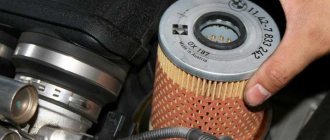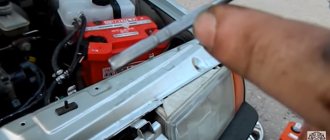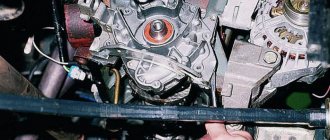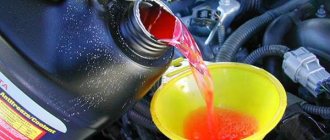Parts and consumables:
- Rags
- Funnel
- Fabric gloves
- Container for draining old oil (about 4 l).
- O-ring for Mazda drain plug - 99561400
- Oil filter for engine 1.6 - B6Y1-14-302-9A
- Oil filter for engine 2.0 - LF10-14-302 9A
- Engine oil MAZDA Original Oil Ultra 5W30 - 0530-05-TFE (5 l.)
- Engine oil Mazda Original Oil Supra 0W-20 8300-77-986 (5 l.)
How much oil is in Mazda 3 (volumes)?
Materials for a comprehensive oil change in automatic transmission Mazda 3 (BK, BL)
Before you proceed to the procedure for changing transmission fluid in a Mazda 3 automatic transmission, purchase the necessary materials and tools. Next, I will present a list of materials and tools that may be required to change the working conditions in an automatic transmission:
- original Mazda ATF MV oil;
- sealant for pan TB1227C00;
- automatic transmission filter JT318K;
- seal for drain plug 995641400;
- gloves;
- container for draining;
- wrenches, ratchet and socket set;
- carbocleaner;
- five liter bottle;
- funnel.
Write in the comments, have you already changed the oil in the Mazda 3 automatic transmission?
Frequency of engine fluid replacement
For a new car, it is advisable to carry out the first replacement after 2,500 km, and, if possible, at a service center. It will be good to replace the initially filled semi-synthetic oil with a high-quality synthetic analogue.
The factory recommends changing the oil for Mazda 3 every 6 months/12,000 km. (whichever comes first). Under no circumstances should you drive for more than 12 months or 17,000 km without replacing it, as this is very harmful to the car. If you frequently drive short distances, in areas where salt is used, have extended periods of idling, or in dusty, cold, extremely hot or mountainous areas, you will need to change your oil more often.
Along with replacing the engine fluid, the oil filter is also replaced.
When to change the fluid in a Mazda 3 automatic transmission
You can find out that it’s time to change the “blood” of the automatic transmission in a simple way. After checking the fluid level in the automatic transmission, drop a drop from the dipstick onto a white napkin or sheet of paper. If the oil stain has a dark color, a pungent odor and metallic impurities, then the Mazda 3 automatic requires immediate maintenance and replacement of the filter and fluid.
Periodic oil changes in automatic transmissions are recommended by experts every 60 thousand km.
What kind of oil should I put in Mazda 3?
Regardless of which engine is installed in the car - 1.6 liters. or 2.0 l., use synthetic oil MAZDA SUPRA 0W20 .
It has protective properties and energy efficiency at the level of API SN and ILSAC GF-5 according to the international classification, and provides the best performance, especially if you are in extreme heat or cold climates.
MAZDA ULTRA 5W30 with ACEA A5/B5 and API SL/CF properties is also perfect
It reliably protects the engine from wear and harmful deposits even in difficult operating conditions, and its resistance to oxidation maintains efficiency throughout the entire interval between replacements.
To extend the maintenance period and protect the engine from damage caused by poor lubrication, it is extremely important to use Mazda 3 engine oil with the correct specification.
Oil change Mazda 3 1.6 l. Work order:
1. To more completely drain the used oil from the system, warm up the engine to a temperature of at least 70°C.
2. Place the vehicle on an inspection ditch or overpass. If this is not possible, use a jack with stands.
3. Open the hood.
4. Unscrew the oil filler cap.
5. Place a container of at least 4 liters under the drain hole of the engine oil pan.
6. Using a 19 mm wrench or socket, unscrew the drain plug.
7. Wait until the liquid is completely drained.
8. Place the container aside.
9. To access the oil filter, a special hole was made in the lower mudguard.
But you can only unscrew the filter element if you have a special oil puller.
Otherwise, you will have to remove the mudguard (7 head nuts for 10 and 2 mounting fasteners).
10. Using a puller or by hand, unscrew the oil filter.
Note:
Be careful: when removing the old element, a significant amount of hot oil will leak out!
11. Using a rag, clean the oil from the mating surface and the filter mounting fitting.
12. Replace the Mazda 3 filter with a new one. Lubricate its rubber gasket with fresh oil.
13. Screw the filter element onto the fitting and tighten it only by hand (using a special tool may damage it).
14. Clean the threads of the drain plug.
15. Replace its copper O-ring.
16. Close the pan drain plug.
17. Go to the engine compartment. Insert a funnel into the filler neck. Slowly pour oil into the Mazda 3 engine.
Note:
Do not immediately fill in the required 3.9 liters, since the old oil is not completely drained. It’s better to fill in 3-3.5 liters first, and then top up as needed.
Exceeding the oil level above the MAX mark can lead to oil leakage through seals, gaskets and the crankcase ventilation system, as well as damage to the exhaust gas catalytic converter.
18. Use the pointer to check the oil level.
The level should be between the two holes corresponding to the MIN and MAX (the difference in volume between the minimum and maximum levels is 1 liter).
19. Screw on the oil filler cap.
20. Run the engine for a few minutes and stop. Re-measure the oil level on the Mazda 3. If it does not reach the bottom mark on the gauge, you need to add fluid.
21. Check to see if oil is leaking from under the filter gasket and drain plug.
Types of transmission fluid changes
There are two ways to change the lubricant in a Mazda 3 automatic transmission:
- Partial oil change in a Mazda 3 automatic transmission. This is a budget method, but it is used only if the lubricant has still retained its properties, has a light color and there is no burnt smell. In this case, the liquid is pumped out to half and partially replaced with fresh one.
(Link to photo source)
- A complete oil change in the Mazda 3 automatic transmission is necessary if it already smells like burning and has acquired a dark tint. The process is performed in a car service using special equipment. The new liquid completely replaces the old one, and the box itself is washed from the dirt accumulated in its depths. The procedure is more expensive, but helps to effectively clean the Mazda 3 automatic transmission.
When a partial lubricant change is not suitable
Naturally, we must take into account that if the Mazda 3's mileage has exceeded a hundred kilometers, and the transmission lubricant has not been changed, then it is better to spend money and change it completely. Otherwise, in the future, defects may appear in the operation of the Mazda 3 automatic and its service life will decrease.
Contrary to the manufacturer’s statements, the transmission loses its physical properties over time and changes its chemical composition. It accumulates contaminants that clog the oil channels. In this case, there are no alternatives - a complete oil change in the Mazda 3 automatic transmission is necessary. Otherwise, unjustified savings will soon result in expensive repairs.
Subtleties of partial and complete automatic oil change
You can carry out a partial oil change in the automatic transmission of the Mazda 3 2008 yourself. This is not a complicated procedure and does not require special equipment. But you shouldn't abuse it. Sometimes it’s still useful to go to a car service center to completely change the lubricant and clean the transmission. This is a guarantee that the Mazda 3 automatic transmission will last as long as possible without causing problems.
But in some regions of the country it can be difficult to find a service station specializing in such work. There is a way out in such cases as well. Some Mazda 3 car owners change the oil partially, 2-3 times, at intervals of 1 thousand kilometers. This way you can replace up to 90% of used lubricant. But I repeat - this is an extreme measure, applicable due to the lack of specialized service stations in a particular region.
Now let’s talk about how much lubricant is in the Mazda 3 automatic transmission. For a partial change you will need about 4 or 5 liters of oil, for a full change - about 8-12 liters.
Oil change Mazda 3 2.0 l. Work order:
1. To more completely drain the used oil from the system, warm up the engine to a temperature of at least 70°C.
2. Place the vehicle on an inspection ditch or overpass.
3. If this is not possible, use racks and jacks.
Note:
On cars with a 2.0 engine of early production years, the oil level indicator and the oil filler cap are located differently.
Cars from early years
Cars of later years
4. Unscrew the oil filler cap and pull out the dipstick.
5. Place a container with a capacity of at least 5 liters under the drain hole of the engine sump.
6. Using a 17mm wrench, unscrew the drain plug.
7. Wait until the liquid is completely drained. Place the container aside.
8. Clean the threads of the drain plug. Replace its copper ring.
9. To access the oil filter, a special hole is made in the lower mudguard.
But, unlike the model with a 1.6 liter engine, the element itself is slightly offset relative to the hole. Therefore, for more convenient removal, we recommend removing the shield.
10. Unscrew the 7 nuts and 2 fasteners securing the shield.
11. Unscrew the oil filter using an oil scraper or by hand.
Note:
Be careful: when removing the old element, a significant amount of hot oil will leak out!
12. Clean the oil from the mating surface and the filter mounting fitting.
13. Lubricate the rubber gasket of the new element with fresh oil.
14. Screw the filter element onto the fitting by hand and tighten it tightly.
15. Close the crankcase drain plug.
16. Go to the engine compartment. Insert a funnel into the filler neck.
17. Slowly pour fresh oil into the engine.
Note:
Since the old oil does not drain completely, do not fill in all the required 4.3 liters at once. First add about 4 liters, and then, if necessary, add more.
Excessive oil levels can cause oil leakage through seals, gaskets and the crankcase ventilation system, as well as damage to the exhaust gas catalytic converter.
18. Check the oil level using the dipstick.
The level on the Mazda 3 oil dipstick should be between the two marks MIN and MAX. The difference in volume between the minimum and maximum levels is 1 liter.
19. Screw the oil filler cap tightly.
20. Run the engine for a few minutes and stop. Check the oil level in the Mazda 3 engine again. If it does not reach the bottom mark on the gauge, add engine fluid.
21. Check to see if oil is leaking from under the filter gasket and drain plug.
22. If the lower mudguard was removed, reinstall it.
Note:
- Be sure to write down the date when you changed the Mazda 3 oil and oil filter.
- Record your car's mileage so you can know when to perform the next procedure.
When to change the oil in a Mazda engine (change frequency)
How can you tell when it's time to change your engine oil? We recommend contacting a car service center without waiting for the scheduled oil change period if the operating modes of the internal combustion engine differ significantly from the statistical average:
- the car drives more often on long-distance highways
- the car is used in commercial activities
- car mileage over 150,000 km
- the engine was overloaded (towing trailers, off-road)
We will quickly change the engine oil and oil filter, and the dealer warranty for your car will be preserved!
Engineers at automakers develop internal combustion engine maintenance regulations for each type of engine: as a rule, this is a period from 10,000 to 15,000 km. In some cases, you should deviate from the regulations and carry out engine maintenance earlier.
TECHNICAL CONDITION OF THE UNIT AND FEATURES OF ITS OPERATION
Engines of cars with mileage of more than 150,000 km already have a degree of wear, albeit small, but this affects the rate of oil clogging and, accordingly, its viscosity. In addition, motors whose service life is coming to an end begin to burn working fluid: its level decreases, and the quality in all respects deteriorates faster. For the engine oil change period, you should take into account not only the mileage, but also the conditions in which the unit operates:
- In the city, the oil can last 600 hours of travel, but on the highway with the same mileage - no more than 250.
- For modern internal combustion engines, speeds of up to 130 km/h are an average or minimum load, therefore this mode does not increase oil wear, but traveling at higher speeds reduces the service life of the engine fluid. Extreme heat or frost also worsens the condition of the unit's lubricant. Extreme driving and off-road conditions - dust, sand, dirt, slipping, steep slopes and potholes - all this forces the vehicle's systems to work to the limit, accordingly reducing the maintenance schedule and replacement of lubricating fluids.
- The composition of the fuel also affects the condition of the oil. Low-quality fuel with a high sulfur content leads to rapid oxidation of the lubricant, and therefore to a deterioration in its properties.
RECOMMENDED OIL CHANGE TIME FOR Mazda
Oil change intervals for gasoline engines:
- Synthetic – 10,000 – 12,000 km
- Semi-synthetic – 8,000 – 12,000 km
- Mineral – 3,000 – 5,000 mileage
Oil change intervals for diesel internal combustion engines:
- Synthetic – 8,000 – 11,000 km
- Semi-synthetic – 6,000 – 11,000 km
- Mineral – 2,000 – 4,000 km
CONSEQUENCES OF OPERATING AN ENGINE WITH CONTAMINED OIL
Engine oil has many functions:
- Heat removal from the unit. A radiator with antifreeze has the same responsibilities, but the oil works directly at the friction points, which increases the quality of cooling of the internal combustion engine.
- Corrosion protection. Engine parts are subject to temperature changes and high loads, which can cause not only mechanical damage, but also metal oxidation. The oil forms a protective film, which protects the metal from rust.
- Cleaning engine parts. The lubricant, circulating through the system, collects carbon deposits, soot, metal shavings and dust, thereby preventing the appearance of scratches on rubbing surfaces.
If the oil is not changed on time, its functionality is significantly reduced: large fractions of wear and combustion products settle on the oil filter and on the oil pan magnet, small fractions remain in the oil, continuing to move along the highways - the oil begins to thicken and loses the ability to lubricate surfaces. The heat dissipation of the substance decreases, and the engine begins to overheat, extraneous sounds appear - knocking, whistling. The most dangerous consequence of running an engine with old oil is the turning of the connecting rod bearings and, as a result, a major overhaul of the engine. You can also encounter engine oil starvation when the camshaft jams, valves bend or piston rings stick, which also leads to a major overhaul of the internal combustion engine.
VIDEO WITH RECOMMENDATIONS ON THE FREQUENCY OF CHANGING OIL IN Mazda ICE
HOW TO KNOW THAT THE ENGINE OIL IS OLD
To determine the condition of the lubricant in the engine, it is enough to examine it visually. To do this you should:
- Warm up the engine.
- Take out the oil dipstick (it has a yellow, red or orange ring-shaped handle and is most often located on the passenger side in the front of the engine - on the cylinder block).
- Drop a little oil onto clean paper.
- Evaluate the resulting drop.
The thicker the consistency of the oil and the darker the color, the worse its properties. Torque Moment specialists recommend not always following the regulations for changing the engine oil for your car, but changing it ahead of schedule if the condition of the lubricant has deteriorated.
BASIC TIPS FOR CHANGING ENGINE OIL
- Engine oil is negatively affected by extreme driving, off-road driving, and frequent traffic jams. Under such conditions, the protective properties of the lubricant are reduced, so try to use reliable synthetic-based motor oil and not extend its service life to the maximum.
- Frequent vehicle downtime is also a factor that negatively affects the condition of the engine oil, leading to the formation of condensation in the engine and a serious change in the chemical composition of the oil fluid. When condensation accumulates, oil can lead to engine corrosion and subsequently serious problems with the internal combustion engine.
- Do not allow the engine to overheat, this reduces the service life of the engine oil and shortens the operating period of the engine.
- Periodically check the condition of the engine oil in the engine using a dipstick: the oil should be transparent without visible inclusions.
- Changing the engine oil must be done with the engine warm.
- The fluid must have a viscosity index that meets the automaker's requirements to protect the engine from damage and wear.
By following these simple oil changes rules, you can extend the life of your car's engine.
VIDEO WITH INSTRUCTIONS FOR INDEPENDENTLY CONDUCTING A TEST FOR THE QUALITY OF ENGINE OIL IN A Mazda ENGINE
Mazda 3 2.0 oil change video:
Analogues of other manufacturers of oil filters for 1.6 engines:
- Ashika 10-03-313 from 205 rubles; Goodwil OG 521 HQ from RUB 203;
- Blue Print ADM52106 from RUB 194; Bosch F 026 407 210 from 252 RUR;
- Green filter OF0137 from 141 RUR; Febi 32099 from 254 RUR;
- Sat ST-15208-AA100 from 153 RUR; MANN-FILTER W 67/1 from 293 RUR;
- Japko 10313 from 155 RUR; Valeo 586 022 from 368 rubles;
- Nipparts J1 317 004 from 157 RUR; WIX 51365 from RUB 398;
- Zekkert OF-4182 from 157 RUR; Mazda B6Y1-14-302 9A from 422 rub.
Analogues of other manufacturers of oil filters for 2.0 engines:
- Stellox 20-50466-SX from 138 RUR; Blue Print ADM52118 from RUB 242;
- Hola SL212 from RUB 172; Sakura C1936SBP from 252 RUR;
- Japan Parts FO-394S from RUB 183; Valeo 586 083 from RUB 303;
- Ashika 10-03-394 from 189 RUR; Jakoparts J1313021 from 310 RUR;
- Goodwill OG 201 HQ from RUB 211; Bosch F 026 407 085 from RUB 318;
- Nipparts J1 313 021 from 228 RUR; MANN-FILTER W 712/73 from 384 RUR;
- Filtron OP 532/2 from RUB 241; WIX 51348MP from RUB 849;
- Mazda LF10-14-302 9A from RUB 1,621
Source: carpedia.club










